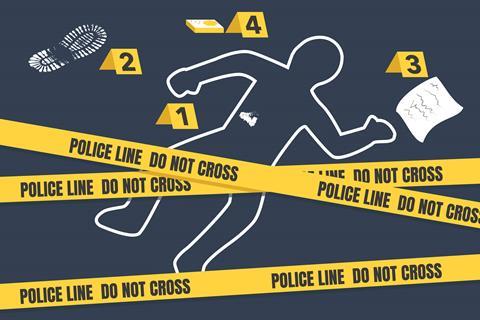How to combine chemical analysis and practical work to solve a crime and engage your younger students

When we had finished our introduction to science topic with our year 7 students, we wanted to build on their practical skills and scientific thinking, so we murdered a teacher.
Students walked into the classroom to learn that one of their science teachers had been murdered. And one of the other science teachers was the murderer, but which one …
Staging a crime
We staged this crime during a school-wide two-day curriculum extension event with all year 7 students. They had a single day, split over two 100-minute lessons, to solve the crime.
To ensure students didn’t suspect our crimes, we recorded all the videos and the 999 call outside normal school areas. We also created a student instruction sheet and uploaded it to the class iPads. On the day, students used the iPads for everything: to get all clues, find out how to do the experiments, and to keep their notes and findings.
Our technicians prepared trays of equipment, one for each of the four suspects and one from the crime scene. Students would use these for their practical work to gather evidence. We divided them into five groups and they rotated around the trays.
Gathering evidence
On the day, we began by playing students the 999 call made by the deputy head of science reporting the murder, saying who she suspected and why. Next, we showed the students videos of the suspects, encouraging them to use their observation skills to make their first deductions. For example, the videos identified two of the teachers as hay fever sufferers.
Using our clues and the instructions, students had to put their chemistry knowledge into action to analyse data and pose hypotheses. They had four experiments to complete (all linked to our GCSE specifications):
1. Powder analysis and flame tests
Compare four solids provided in small Petri dishes with the crime scene sample (which contained potassium ions) using a flame test (GCSE chemistry).
2. pH analysis of mud
Discover which of four mud samples in labelled jars matches the pH of a sample of the muddy footprint from the crime scene, using universal indicator paper (GCSE combined science).
3. Chromatography
Run chromatograms of four pens and compare them with a picture of a chromatogram from the ink of a pen found at the crime scene (GCSE combined science).
4. Biuret test for antihistamine in urine
Test four urine samples for antihistamine (protein) using a Biuret test to identify which suspects have taken hay fever medication (GCSE biology).
More practical puzzles
Want more chemistry-related practical mystery activities for students? Check out our escape room puzzles.
Evaluating results
We arranged the clues so there were multiple suspects through the day, which meant students had to work through all the tasks, evaluating the evidence from the experiments to narrow it down a prime suspect.Some evidence was a red herring, for example the powder analysis. The powder could have been on the teachers’ clothing simply because they were in the same room. The urine analysis was more reliable, but it led to two suspects, which again meant students had to evaluate evidence.
In their groups, students debated the evidence, learning that as they accumulated more evidence the suspect could change. We liked this aspect as it mimics the cycle of scientific progress where ideas are modified and revised to explain new experimental results. In fact, as a teaching team we chose this activity because we felt it would reinforce scientific methodology and students’ practical skills, while giving us opportunities to make links with careers in forensics and criminology – all the time keeping students interested. We’d identified five learning outcomes: developing practical skills; handling chemicals safely; following a method; problem solving and evaluating evidence. Although we ran this activity with our youngest (11- and 12-year old) students, we could also use it with older age groups. We just hope the students enjoyed it as much as we did.
With thanks to our colleague, Nina Bull who now teaches in York, for creating the activities.
Put this in context
Learn about the role of a forensic scientist who investigates biological samples for the presence of drugs and alcohol and also examines evidence seized by the police.









1 Reader's comment